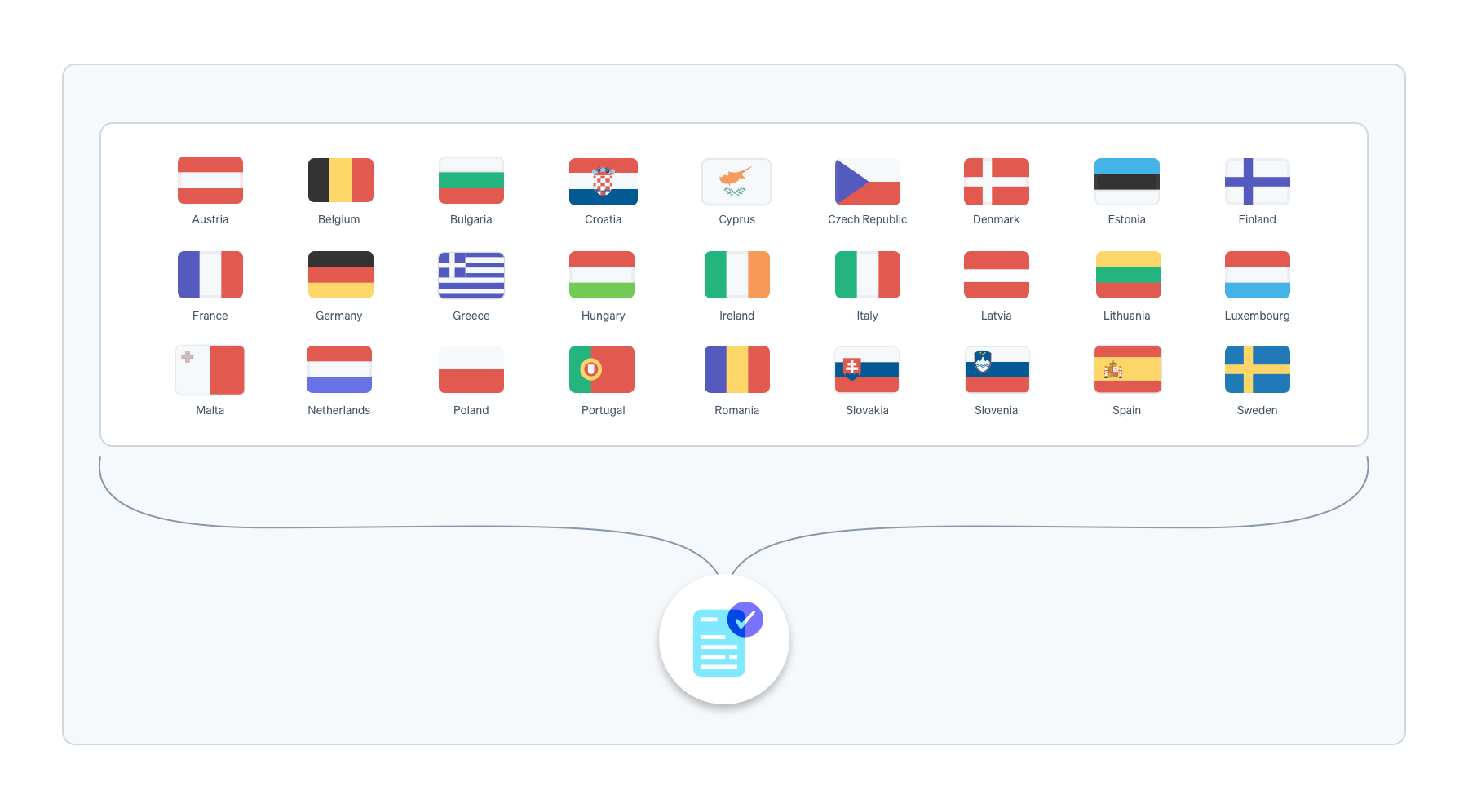การดําเนินงานด้านภาษีเป็นเรื่องที่ท้าทายสําหรับทุกบริษัท โดยเฉพาะอย่างยิ่ง ธุรกิจในยุโรป ทั้งนี้ในยุโรป กฎภาษีที่บังคับใช้จะแตกต่างกันไป ขึ้นอยู่กับว่าคุณตั้งอยู่ในประเทศสมาชิกสหภาพยุโรปหรือไม่ และคุณกำลังขายให้กับธุรกิจหรือบุคคล
วิธีจดทะเบียนภาษีมูลค่าเพิ่มในยุโรป
อันดับแรก คุณจะต้องตรวจสอบว่าคุณต้องเรียกเก็บภาษีมูลค่าเพิ่ม (VAT)หรือไม่ ขั้นตอนต่อไปคือการจดทะเบียนกับหน่วยงานภาษีที่เหมาะสม เมื่อจดทะเบียนแล้ว คุณจะเริ่มเรียกเก็บและนําส่งภาษีมูลค่าเพิ่มได้ โปรดทราบว่าแนวทางเหล่านี้เกี่ยวข้องกับผู้ขายโดยตรง หากขายสินค้าหรือบริการเฉพาะในมาร์เก็ตเพลสโดยเฉพาะ คุณควรปรึกษาผู้เชี่ยวชาญด้านภาษีเพื่อหาแนวทางที่ดีที่สุดเนื่องจากกฎสําหรับผู้ขายมาร์เก็ตเพลสอาจแตกต่างกันออกไป
คู่มือนี้จะกล่าวถึงกรณีที่ธุรกิจจําเป็นต้องจดทะเบียนภาษีมูลค่าเพิ่มในประเทศสมาชิกของสหภาพยุโรป สหราชอาณาจักร นอร์เวย์ และสวิตเซอร์แลนด์ โปรดทราบว่าเนื้อหาของคู่มือนี้เขียนขึ้นสำหรับธุรกิจที่ทำการขายนอกประเทศบ้านเกิดของตน สุดท้ายนี้ เราจะอธิบายวิธีที่ Stripe สามารถช่วยคุณจัดการการปฏิบัติตามข้อกําหนดด้านภาษีได้อย่างต่อเนื่อง
การจดทะเบียนเพื่อเรียกเก็บภาษีมูลค่าเพิ่มในสหภาพยุโรป
ต้องจดทะเบียนเมื่อไร
หากคุณทำธุรกรรมที่ต้องเสียภาษีในประเทศในสหภาพยุโรปอื่นที่ไม่ใช่ประเทศที่คุณตั้งถิ่นฐานอยู่ โดยทั่วไปแล้ว คุณต้องจดทะเบียนเพื่อเรียกเก็บภาษีมูลค่าเพิ่มในประเทศนั้น เว้นแต่ธุรกรรมนั้นจะได้รับการยกเว้นหรือต้องเสียภาษีย้อนกลับ (ซึ่งโดยทั่วไปจะใช้ในสถานการณ์ธุรกิจต่อธุรกิจ [B2B] เช่น ข้อเสนอการให้บริการระบบซอฟต์แวร์ [SaaS]) ผู้ขายแบบธุรกิจต่อผู้บริโภค (B2C) ในสหภาพยุโรปอาจได้รับประโยชน์จากกระบวนการจดทะเบียนที่ง่ายขึ้นที่เรียกว่าแผน VAT One Stop Shop (VAT OSS) แบบในสหภาพซึ่งช่วยให้ผู้ขายสามารถรายงานภาษีมูลค่าเพิ่มที่ต้องชำระในประเทศสหภาพยุโรปอื่นๆ ในประเทศที่ตนจัดตั้งธุรกิจได้
กฎเกณฑ์ที่คล้ายกันนี้มีผลกับผู้ขายนอกสหภาพยุโรป โดยต้องเรียกเก็บภาษีมูลค่าเพิ่มโดยเริ่มจากธุรกรรมที่ต้องเสียภาษีรายการแรกที่ดําเนินการในสหภาพยุโรป เว้นแต่จะได้รับการยกเว้นหรืออาจมีการเรียกเก็บย้อนกลับ ธุรกิจนอกสหภาพยุโรปที่ขายบริการดิจิทัลให้กับบุคคลในประเทศสมาชิกสหภาพยุโรปหลายประเทศสามารถลงทะเบียนสำหรับเข้าร่วมแผน VAT One Stop Shop (VAT OSS) แบบนอกสหภาพได้ อย่างไรก็ตาม แผนนี้ไม่สามารถใช้ได้กับสินค้าที่จับต้องได้ ธุรกิจนอกสหภาพยุโรปที่ขายสินค้าภายในสหภาพยุโรปจะต้องจดทะเบียนเข้าร่วมแผน VAT OSS แบบในสหภาพ
ผู้ขายที่ขายสินค้าแบบ B2C (เช่น การขายปลีก) ที่นําเข้าจากประเทศนอกสหภาพยุโรปเข้าสู่สหภาพยุโรปโดยมีมูลค่าสินค้าต่ำกว่า 150 ยูโร สามารถลงทะเบียนเพื่อเข้าร่วม VAT Import One Stop Shop (VAT IOSS) ได้ โดยแผน OSS ที่เรียบง่ายทั้งหมดนั้นขึ้นอยู่กับความสมัครใจ
วิธีจดทะเบียนหมายเลขประจำตัวผู้เสียภาษีมูลค่าเพิ่ม
แม้ว่าธุรกิจต่างๆ จะสามารถจดทะเบียนในประเทศต่างๆ เพื่อจัดเก็บภาษีมูลค่าเพิ่มได้ แต่ธุรกิจในสหภาพยุโรปที่ขายสินค้าให้กับบุคคลในประเทศต่างๆ ในสหภาพยุโรปหลายแห่งจะได้รับประโยชน์จากการจดทะเบียนเข้าร่วมแผน VAT OSS แบบในสหภาพ แผนนี้ถูกสร้างขึ้นเพื่อลดความยุ่งยากของกระบวนการการจัดเก็บและชำระภาษีมูลค่าเพิ่มในประเทศต่างๆ ภายในสหภาพยุโรปโดยเฉพาะ โดยแผน VAT OSS แบบในสหภาพช่วยให้คุณไม่ต้องจดทะเบียนกับแต่ละประเทศในสหภาพยุโรปที่คุณจําหน่ายสินค้าหรือบริการจากทางไกล และธุรกิจในสหภาพยุโรปต้องจดทะเบียน VAT OSS ในประเทศสหภาพยุโรปที่ธุรกิจของตนก่อตั้งขึ้น

ภาพแสดงประเทศในสหภาพยุโรปที่เข้าร่วม VAT OSS
มีข้อยกเว้นสำหรับธุรกิจในสหภาพยุโรปที่ตั้งอยู่ในประเทศในสหภาพยุโรปแห่งหนึ่ง แต่ขายสินค้าที่จับต้องได้และผลิตภัณฑ์ดิจิทัลให้กับบุคคลในประเทศอื่นในสหภาพยุโรป ในการขาย B2C เหล่านี้ ธุรกิจสามารถเก็บภาษีมูลค่าเพิ่มในอัตราของประเทศที่พำนักของตนได้แทนที่จะเป็นอัตราในประเทศที่พำนักของลูกค้า แต่เมื่อการขาย B2C มีมูลค่าเกิน 10,000 ยูโร ผู้ขายจะต้องเก็บภาษีในอัตราของประเทศที่พำนักของลูกค้า หากการขายของคุณต่ำกว่าเกณฑ์ การจดทะเบียน VAT ภายในประเทศก็เพียงพอแล้ว
ตัวอย่างเช่น หากกิจการของคุณตั้งอยู่ในออสเตรียแต่ขายบริการดิจิทัลให้กับบุคคลทั่วไปในอิตาลี โดยรายรับรวมจากการขาย B2C ของสินค้าหรือบริการให้กับผู้บริโภคมีมูลค่าต่ำกว่า 10,000 ยูโร คุณจะต้องเก็บภาษีมูลค่าเพิ่มในอัตราของออสเตรีย ไม่ใช่ภาษีมูลค่าเพิ่มของอิตาลี ในกรณีนี้การจดทะเบียน VAT ภายในประเทศก็เพียงพอแล้ว แต่เมื่อการขาย B2C ของคุณเกิน 10,000 ยูโร คุณจะต้องเก็บภาษีมูลค่าเพิ่มตามอัตราของอิตาลี
ธุรกิจนอกสหภาพยุโรปที่ขายบริการให้กับบุคคลทั่วไปในหลายประเทศในสหภาพยุโรป และเลือกใช้แผน VAT OSS แบบนอกสหภาพสามารถเลือกประเทศในสหภาพยุโรปที่ต้องการจดทะเบียนได้ ธุรกิจนอกสหภาพยุโรปที่ขายสินค้าที่ตั้งอยู่ภายในสหภาพยุโรปต้องจดทะเบียนในแผน VAT OSS Union ในประเทศสหภาพยุโรปที่เป็นจุดเริ่มต้นการขนส่งสินค้า หากสินค้าส่งจากมากกว่าหนึ่งประเทศ ผู้ขายสามารถเลือกประเทศที่จะจดทะเบียนได้
ผู้ขายในสหภาพยุโรปต้องจดทะเบียน IOSS ในประเทศที่ตั้งธุรกิจ ผู้ขายนอกสหภาพยุโรปที่ไม่ได้ตั้งอยู่ในประเทศที่สหภาพยุโรปได้ทำข้อตกลงเกี่ยวกับความช่วยเหลือกันด้านการเก็บภาษีมูลค่าเพิ่มต้องแต่งตั้งตัวกลางเพื่อใช้ IOSS หากผู้ขายตั้งอยู่นอกสหภาพยุโรป แต่อยู่ในประเทศที่สหภาพยุโรปได้ทำข้อตกลงเกี่ยวกับความช่วยเหลือกันด้านการเก็บภาษีมูลค่าเพิ่มและขายสินค้านำเข้าจากประเทศนั้น ผู้ขายสามารถเลือกประเทศสมาชิกใดในสหภาพยุโรปเป็นประเทศจด่ทะเบียน ในกรณีนี้ไม่จำเป็นต้องแต่งตั้งตัวกลางเพื่อใช้ IOSS อย่างไรก็ตาม หากผู้ขายขายสินค้านำเข้าจากประเทศอื่น จะต้องมีตัวกลางเพื่อใช้ IOSS
หากคุณเกินเกณฑ์ภาษีในสหภาพยุโรปและกังวลว่าคุณจะต้องจ่ายค่าปรับและภาษีย้อนหลัง เราขอแนะนำให้คุณติดต่อขอรับคำแนะนำจากผู้เชี่ยวชาญด้านภาษี คุณจะเริ่มเก็บภาษีมูลค่าเพิ่มได้เมื่อจดทะเบียนแล้ว อย่าเริ่มเก็บภาษีมูลค่าเพิ่มจนกว่าคุณจะจดทะเบียนอย่างถูกต้องแล้ว
การจดทะเบียนเพื่อเรียกเก็บภาษีมูลค่าเพิ่มในสหราชอาณาจักร
ต้องจดทะเบียนเมื่อไร
ธุรกิจที่ต้องการจําหน่ายสินค้าหรือบริการในสหราชอาณาจักรจะต้องจดทะเบียนภายใน 30 วันหลังทําธุรกรรมที่ต้องเสียภาษีรายการแรกในสหราชอาณาจักร นอกจากนี้ คุณยังต้องรับผิดต่อการจดทะเบียนหากคุณมีเหตุอันผลสมเหตุสมผลที่เชื่อว่าคุณจะมีธุรกรรมที่ต้องเสียภาษีภายใน 30 วัน
ธุรกรรมที่ต้องเสียภาษีคือการขายใดๆ ในสหราชอาณาจักรที่ไม่ได้รับการยกเว้นภาษีมูลค่าเพิ่ม หรือไม่มีการเรียกเก็บย้อนกลับ (หมายความว่าลูกค้าต้องรับผิดชอบในการทําบัญชีภาษีมูลค่าเพิ่ม) ธุรกรรมที่ต้องเสียภาษีหมายรวมถึงธุรกรรมที่มีอัตราภาษีมูลค่าเพิ่มเป็นศูนย์สําหรับวัตถุประสงค์ด้านภาษีมูลค่าเพิ่ม
ตัวอย่างเช่น หากคุณอยู่ในสหรัฐอเมริกาและขายบริการดิจิทัลให้แก่ลูกค้าในสหราชอาณาจักร คุณต้องจดทะเบียนในสหราชอาณาจักรในทันทีที่คุณมีเหตุผลอันสมเหตุสมผลที่เชื่อได้ว่าผู้บริโภคในสหราชอาณาจักรจะซื้อบริการของคุณ หากผู้บริโภคในสหราชอาณาจักรซื้อบริการดิจิทัลของคุณจริงๆ คุณต้องจดทะเบียนภายใน 30 วันหลังจากทําการขาย อย่างไรก็ตาม หากคุณจําหน่ายผลิตภัณฑ์หรือบริการให้แก่ธุรกิจในสหราชอาณาจักรเพียงอย่างเดียว คุณก็ไม่จําเป็นต้องลงทะเบียน เนื่องจากยอดขายดังกล่าวจะต้องมีการเรียกเก็บย้อนกลับและไม่ใช่ธุรกรรมที่ต้องเสียภาษีซึ่งใช้เพื่อจุดประสงค์ด้านภาษีมูลค่าเพิ่มของสหราชอาณาจักร
ธุรกิจที่ขายสินค้าแบบ B2C (เช่น การขายปลีก) ที่นำเข้าจากต่างประเทศมายังสหราชอาณาจักรโดยมีมูลค่าสินค้าต่ำกว่า 135 ปอนด์ จะต้องรับผิดชอบในการเรียกเก็บภาษีมูลค่าเพิ่มของสหราชอาณาจักร และควรจดทะเบียนเพื่อเรียกเก็บภาษีมูลค่าเพิ่ม
หากการขายสินค้าที่นําเข้ามูลค่าต่ําเป็นแบบ B2B ผู้ขายไม่จําเป็นต้องเรียกเก็บภาษีมูลค่าเพิ่มตราบใดที่ผู้ซื้อเป็นธุรกิจในสหราชอาณาจักรและได้ระบุหมายเลขจดทะเบียนภาษีมูลค่าเพิ่มในสหราชอาณาจักรแล้ว
วิธีจดทะเบียนหมายเลขประจำตัวผู้เสียภาษีมูลค่าเพิ่ม
นับตั้งแต่ Brexit สหราชอาณาจักรมีกระบวนการลงทะเบียนภาษีมูลค่าเพิ่มที่แยกจาก OSS ภาษีมูลค่าเพิ่มของสหภาพยุโรป ธุรกิจต่างๆ สามารถจดทะเบียนภาษีมูลค่าเพิ่มในสหราชอาณาจักรได้โดยใช้พอร์ทัลออนไลน์นี้ ทั้งนี้สหราชอาณาจักรไม่มีขั้นตอนการจดทะเบียนอย่างง่ายสำหรับผู้ขายที่ไม่ใช่ผู้มีถิ่นที่อยู่ในประเทศ
หากคุณมีภาษีเกินเกณฑ์ในสหราชอาณาจักรและกังวลว่าคุณจะต้องจ่ายค่าปรับและภาษีย้อนหลัง เราขอแนะนําให้คุณติดต่อผู้เชี่ยวชาญด้านภาษีเพื่อขอคําแนะนํา คุณจะเริ่มเรียกเก็บภาษีมูลค่าเพิ่มได้เมื่อจดทะเบียนแล้ว อย่าเริ่มเรียกเก็บภาษีมูลค่าเพิ่มจนกว่าคุณจะจดทะเบียนอย่างถูกต้อง
การจดทะเบียนเพื่อเรียกเก็บภาษีมูลค่าเพิ่มในนอร์เวย์
ต้องจดทะเบียนเมื่อไร
หากธุรกิจของคุณอยู่นอกนอร์เวย์และจําหน่ายสินค้าหรือบริการให้แก่ลูกค้าในนอร์เวย์ คุณต้องจดทะเบียนทันทีที่ยอดขายที่ต้องเสียภาษีในนอร์เวย์ของคุณถึง 50,000 NOK ภายในระยะเวลา 12 เดือน จํานวนนี้ไม่รวมยอดขายที่มีการเรียกเก็บเงินปรับคืน (ซึ่งโดยทั่วไปจะใช้กับการขายแบบ B2B) ในสถานการณ์เหล่านี้ ลูกค้ามีหน้าที่คำนวณภาษีมูลค่าเพิ่มในแบบแสดงรายการภาษีมูลค่าเพิ่ม
วิธีจดทะเบียนหมายเลขประจำตัวผู้เสียภาษีมูลค่าเพิ่ม
ธุรกิจที่ตั้งอยู่ในเขตเศรษฐกิจยุโรป (EEA) สามารถจดทะเบียนกับหน่วยงานภาษีของนอร์เวย์ได้โดยตรง ธุรกิจที่อยู่นอกเขตเศรษฐกิจยุโรปต้องแต่งตั้งตัวแทนภาษีมูลค่าเพิ่มของนอร์เวย์ เว้นแต่จะใช้ขั้นตอนการจดทะเบียนแบบง่าย (ภาษีมูลค่าเพิ่มสำหรับอีคอมเมิร์ซ หรือ VOEC) ที่สามารถใช้กับการขายบริการดิจิทัลและการขายสินค้าแบบ B2C มูลค่าต่ำ (ต่ำกว่า 3,000 โครนนอร์เวย์ ธุรกิจต่างชาติสามารถจดทะเบียน VOEC ได้โดยใช้พอร์ทัลออนไลน์นี้
ตัวอย่างเช่น หากกิจการของคุณตั้งอยู่ในสหรัฐอเมริกา ขายบริการดิจิทัลให้กับผู้บริโภคในนอร์เวย์ และเกินเกณฑ์ในช่วง 12 เดือน (ตั้งแต่เดือนกุมภาพันธ์ของปีที่ผ่านมาจนถึงเดือนมกราคมของปีปัจจุบัน) คุณต้องจดทะเบียนในนอร์เวย์ แต่หากคุณจําหน่ายบริการดิจิทัลให้กับธุรกิจนอร์เวย์เท่านั้น คุณก็ไม่จําเป็นต้องจดทะเบียน เนื่องจากบริการเหล่านี้ต้องเสียภาษีการเรียกเก็บเงินปรับคืน
หากคุณเกินเกณฑ์ภาษีในนอร์เวย์และกังวลว่าจะต้องจ่ายค่าปรับและภาษีย้อนหลัง เราขอแนะนำให้คุณติดต่อขอรับคำแนะนำจากผู้เชี่ยวชาญด้านภาษี คุณจะเริ่มเก็บภาษีมูลค่าเพิ่มได้เมื่อจดทะเบียนแล้ว อย่าเริ่มเก็บภาษีมูลค่าเพิ่มจนกว่าคุณจะจดทะเบียนอย่างถูกต้องแล้ว
การจดทะเบียนเพื่อเรียกเก็บภาษีมูลค่าเพิ่มในสวิตเซอร์แลนด์
ต้องจดทะเบียนเมื่อไร
หากคุณอยู่นอกสวิตเซอร์แลนด์และมีรายรับทั่วโลกเกิน 100,000 ฟรังก์สวิส หรือจะมีเกินจํานวนนี้ในช่วง 12 เดือนข้างหน้า คุณต้องจดทะเบียนภาษีมูลค่าเพิ่มในสวิตเซอร์แลนด์ภายใน 30 วันหลังจากทําธุรกรรมที่ต้องเสียภาษีรายการแรก โดยคุณจะไม่มีหน้าที่ในการจดทะเบียนหาก:
- คุณขายสินค้าหรือบริการให้แก่ธุรกิจในสวิตเซอร์แลนด์เท่านั้น (การขายแบบ B2B) และยอดขายอาจมีการเรียกเก็บย้อนกลับในสวิตเซอร์แลนด์
- คุณให้บริการที่ได้รับการยกเว้นภาษีแก่ลูกค้าในสวิตเซอร์แลนด์เท่านั้น
สวิตเซอร์แลนด์ใช้กฎพิเศษในการนําเข้าสินค้าที่มีมูลค่าต่ํา สินค้าที่มีมูลค่าต่ำ หมายถึง สินค้าที่มีมูลค่า (รวมค่าขนส่ง) ต่ำกว่า 62 ฟรังก์สวิส ซึ่งต้องเสียภาษีตามอัตราปกติ 8.1% และสินค้าที่มีมูลค่าต่ำกว่า 193 ฟรังก์สวิส ซึ่งต้องเสียภาษีตามอัตราลดหย่อน 2.6% หากผู้ขายที่อยู่นอกสวิตเซอร์แลนด์มีรายรับเกิน 100,000 ฟรังก์สวิสจากการขายที่มีมูลค่าต่ํา สถานที่จําหน่ายจะเปลี่ยนมาที่สวิตเซอร์แลนด์ โดยผู้ขายจะต้องจดทะเบียนภาษีมูลค่าเพิ่มและเรียกเก็บภาษีมูลค่าเพิ่มสําหรับการขายทุกรายการ
วิธีจดทะเบียนหมายเลขประจำตัวผู้เสียภาษีมูลค่าเพิ่ม
ไม่มีกระบวนการจดทะเบียนภาษีมูลค่าเพิ่มแบบง่ายสำหรับผู้ที่ไม่ใช่ผู้มีถิ่นที่อยู่ในประเทศ ผู้ขายที่ไม่ใช่ผู้มีถิ่นที่อยู่ในประเทศจะต้องแต่งตั้งตัวแทนด้านภาษี และอาจต้องมีการค้ำประกันจากธนาคารในบางโอกาส คุณสามารถจดทะเบียนออนไลน์ผ่านลิงก์นี้ คุณต้องระบุข้อมูลเกี่ยวกับตัวแทนภาษีเมื่อจดทะเบียนออนไลน์
หากคุณมีภาษีเกินเกณฑ์ในสวิตเซอร์แลนด์และกังวลว่าคุณจะต้องจ่ายค่าปรับและภาษีย้อนหลัง เราขอแนะนําให้คุณติดต่อผู้เชี่ยวชาญด้านภาษีเพื่อขอคําแนะนํา คุณจะเริ่มเรียกเก็บภาษีมูลค่าเพิ่มได้เมื่อจดทะเบียนแล้ว อย่าเริ่มเรียกเก็บภาษีมูลค่าเพิ่มจนกว่าคุณจะจดทะเบียนอย่างถูกต้อง
Stripe Tax ช่วยเหลือคุณได้อย่างไร
Stripe อำนวยความสะดวกให้มาร์เก็ตเพลสสร้างและขยายธุรกิจการชำระเงินและบริการทางการเงินระดับโลกที่ทรงประสิทธิภาพได้ โดยใช้เวลาการทำงานน้อยลงและมีโอกาสในการเติบโตมากขึ้น Stripe Tax ลดความซับซ้อนในการปฏิบัติตามข้อกำหนดด้านภาษีทั่วโลก เพื่อให้คุณมีเวลาทุ่มเทกับการพัฒนาธุรกิจให้เติบโต โดยระบบจะคำนวณและเก็บภาษีการขาย ภาษีมูลค่าเพิ่ม และภาษีสินค้าและบริการโดยอัตโนมัติจากทั้งสินค้าที่จับต้องได้และสินค้าดิจิทัล รวมไปถึงบริการในทุกรัฐของสหรัฐอเมริกาและอีกกว่า 100 ประเทศ Stripe Tax สร้างขึ้นภายใน Stripe โดยเฉพาะ และช่วยให้คุณเริ่มใช้งานได้รวดเร็วขึ้นโดยที่ไม่ต้องมีการผสานการทำงานหรือใช้ปลั๊กอินของบริษัทอื่น
Stripe Tax สามารถช่วยคุณทำสิ่งต่อไปนี้
ทำความเข้าใจว่าจะต้องจดทะเบียนและเรียกเก็บภาษีที่ไหน ดูประเทศที่คุณต้องเรียกเก็บภาษีตามธุรกรรมใน Stripe และหลังจากจดทะเบียนแล้ว ก็สามารถเปลี่ยนไปใช้การเรียกเก็บภาษีในรัฐหรือประเทศใหม่ได้ในไม่กี่วินาที คุณจะเริ่มเรียกเก็บภาษีได้โดยเพิ่มโค้ดเพียงบรรทัดเดียวลงในการเชื่อมต่อการทำงาน Stripe ที่ใช้อยู่ หรือเพิ่มการเรียกเก็บภาษีลงในผลิตภัณฑ์ Stripe ที่ไม่ต้องใช้การเขียนโค้ด เช่น Invoicing ด้วยการคลิกเพียงปุ่มเดียว
จดทะเบียนเพื่อจ่ายภาษี: หากธุรกิจของคุณอยู่ในสหรัฐอเมริกา ให้ Stripe ช่วยจัดการการจดทะเบียนภาษี และคุณจะได้รับขั้นตอนที่ง่ายขึ้น โดยระบบจะกรอกรายละเอียดการยื่นจดทะเบียนให้ล่วงหน้า ซึ่งช่วยประหยัดเวลาและลดความยุ่งยากในการปฏิบัติตามกฎระเบียบในท้องถิ่น หากคุณอยู่นอกสหรัฐอเมริกา Stripe จะร่วมมือกับ Taxually เพื่อช่วยคุณจดทะเบียนกับหน่วยงานด้านภาษีในท้องถิ่น
เรียกเก็บภาษีการขายโดยอัตโนมัติ: Stripe Tax คำนวณและเรียกเก็บเงินภาษีที่ค้างชำระตามจำนวนที่ถูกต้องไม่ว่าคุณจะจำหน่ายผลิตภัณฑ์อะไรก็ตาม รองรับผลิตภัณฑ์และบริการหลายร้อยรายการและคอยอัปเดตเกี่ยวกับกฎและการเปลี่ยนแปลงอัตราภาษี
ทำให้การยื่นและนำส่งเป็นเรื่องง่ายขึ้น: พาร์ทเนอร์ทั่วโลกที่ได้รับความไว้วางใจของเราจะช่วยให้ผู้ใช้ได้รับประสบการณ์ที่ราบรื่นซึ่งเชื่อมต่อกับข้อมูลธุรกรรมใน Stripe ของคุณ ให้พาร์ทเนอร์ของเราช่วยจัดการการยื่นเอกสารให้คุณ เพื่อให้คุณมีเวลาไปมุ่งเน้นในการพัฒนาธุรกิจให้เติบโต
ดูข้อมูลเพิ่มเติมเกี่ยวกับ Stripe Tax